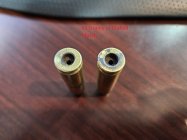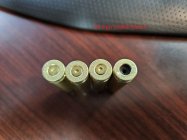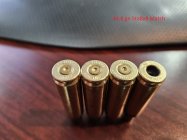Hi All,
This is my first post asking for help, but i've been around in the classifieds for a bit. I am relatively new to this long range stuff (f-class) and have been shooting a Howa 1500 in 308. When i first started i was using the Hornady Match BHTP 168's and had no issues at 1k other than my SD and ES being extreme.
One of the guys I shoot with said to switch up to 175 SMK's. I did this and at 1k I'm struggling to get them moving fast enough to be picked up consistently with our Shot Marker targets. Last time i was at the store i saw some ELD-Match in 168 i picked up.
This is where things get interesting. The rifle is a 'stock' Howa 1500 with 24" 'heavy barrel'. I am now using Staball Match powder and the ELD-M's.
Today i figured i needed to do some load workup for the new projectiles. I know both the 168 BTHP and the 175 SMK's liked to be on the upper end of the spec on Hodgdon's site. So i loaded up groups of 5 from max down ten groups. From 44.8 - 46.8gn of Staball Match powder, the 168 ELD Match and Lapua brass (3 firings on them and annealed)
I went today to chrono the loads and started at the bottom at 44.8 gn.
The first 3 rounds shot great, seemed to be fairly accurate and felt good, the 4th round popped a primer out. The Magnetospeed measured
I loaded the next charge weight of 45gn in and the next two shots popped primers out and did not register on the chrono. I stopped at this point as I figured if im popping primers at 45 there is no reason to go higher.
Hodgdon lists the data from 42.7 - 46.8 with Sierra BTHP and 42.4 - 46.4 with Barnes TTSX
My reloading process is as follows
1. Universally deprime brass
2. wet tumble with stainless media
3. lube with alcohol/lanolin oil
4. Size with Hornady full length sizing die and a 333 bushing (i think its 333 i dont remember for sure)
5. Quickly wet tumble again to remove lube
6. Load on Dillon 550 - Station 1: Wilson Expanding Mandrel, Station 2: Dillon powder die with funnel adapter, Station 3: Frankford arsenal bullet seating die
Up until now, I have never seen pressure signs this 'far' from the max that i see listed. Just figured i'd ask if anyone has any advice. I am concerned that at what my rifle seemed to put the max of 44.8gn's at im not pushing these fast enough to carry enough velocity at the 1k line for the targets to work consistently.
Thank you in advance, attached are some pictures of my fired cases the two grouped together are the 45gn - i see the ejector marks. Maybe it's me, but the 3 with primers from the 44.8 dont look over pressure to me - but like i said im new to this.
This is my first post asking for help, but i've been around in the classifieds for a bit. I am relatively new to this long range stuff (f-class) and have been shooting a Howa 1500 in 308. When i first started i was using the Hornady Match BHTP 168's and had no issues at 1k other than my SD and ES being extreme.
One of the guys I shoot with said to switch up to 175 SMK's. I did this and at 1k I'm struggling to get them moving fast enough to be picked up consistently with our Shot Marker targets. Last time i was at the store i saw some ELD-Match in 168 i picked up.
This is where things get interesting. The rifle is a 'stock' Howa 1500 with 24" 'heavy barrel'. I am now using Staball Match powder and the ELD-M's.
Today i figured i needed to do some load workup for the new projectiles. I know both the 168 BTHP and the 175 SMK's liked to be on the upper end of the spec on Hodgdon's site. So i loaded up groups of 5 from max down ten groups. From 44.8 - 46.8gn of Staball Match powder, the 168 ELD Match and Lapua brass (3 firings on them and annealed)
I went today to chrono the loads and started at the bottom at 44.8 gn.
The first 3 rounds shot great, seemed to be fairly accurate and felt good, the 4th round popped a primer out. The Magnetospeed measured
| Series | Shot | Speed | |
1 | 1 | 2592 | ft/sec |
1 | 2 | 2612 | ft/sec |
1 | 3 | 2600 | ft/sec |
1 | 4 | 2592 | ft/sec |
I loaded the next charge weight of 45gn in and the next two shots popped primers out and did not register on the chrono. I stopped at this point as I figured if im popping primers at 45 there is no reason to go higher.
Hodgdon lists the data from 42.7 - 46.8 with Sierra BTHP and 42.4 - 46.4 with Barnes TTSX
My reloading process is as follows
1. Universally deprime brass
2. wet tumble with stainless media
3. lube with alcohol/lanolin oil
4. Size with Hornady full length sizing die and a 333 bushing (i think its 333 i dont remember for sure)
5. Quickly wet tumble again to remove lube
6. Load on Dillon 550 - Station 1: Wilson Expanding Mandrel, Station 2: Dillon powder die with funnel adapter, Station 3: Frankford arsenal bullet seating die
Up until now, I have never seen pressure signs this 'far' from the max that i see listed. Just figured i'd ask if anyone has any advice. I am concerned that at what my rifle seemed to put the max of 44.8gn's at im not pushing these fast enough to carry enough velocity at the 1k line for the targets to work consistently.
Thank you in advance, attached are some pictures of my fired cases the two grouped together are the 45gn - i see the ejector marks. Maybe it's me, but the 3 with primers from the 44.8 dont look over pressure to me - but like i said im new to this.













